Eduard 1/48 early Spitfire I
By the spring of 1940, Spitfires equipped approximately one-third of the squadrons in Fighter Command. Over that summer, the pilots of the Spitfires and their more numerous comrades in the cockpits of Hawker Hurricanes successfully stopped the Luftwaffe offensive in the Battle of Britain.
The Supermarine Type 300 prototype K5054 first flew on March 5, 1936. Upon landing, Vickers Chief Test Pilot “Mutt” Summers famously declared, “Don't change a thing!” At that point, 310 Spitfire I fighters were already on order. It was officially named “Spitfire” (rather than “Shrew”) on June 10.
Production initially lagged due to the fact Supermarine had never mass-produced an airplane in its entire existence. The problem was finally solved by creating an extensive network of sub-contractors, who eventually produced four-fifths of all the parts and sub-assemblies of the airplane, though Supermarine's management initially resisted the idea of giving potential competitors the blueprints. The biggest obstacle was production of the difficult-to-produce elliptical wing, with hand-fabricated and finished fuselages sitting on the production line awaiting wings. As a result of the delays in getting the Spitfire into full production, the Air Ministry put forward a plan that its production be stopped after the initial order for 310, after which Supermarine would build Bristol Beaufighters. The managements of Supermarine and Vickers were able to convince the Air Ministry that production problems could be overcome, and a further order was placed for 200 Spitfires on March 24, 1938.The first production Spitfire, K9787, was flown by production test pilot Jeffrey Quill on May 15, 1938.
These first Spitfires were equipped with a Merlin II engine equipped with a single-stage/single-speed supercharger giving 1,030 h.p. on 87-octane avgas. The first 78 used a Watts two-blade wooden propeller, later replaced by a deHavilland 2-speed adjustable three-blade metal prop. The Merlins, which were hand-built by Rolls-Royce (Merlins were still hand-built till Packard got their hands on the engine and showed the British what mass-production means). They were leaky and subject to power loss initially.
19 Squadron at Duxford, commanded by Squadron Leader Henry Cozens and flying Gloster Gauntlets was the first RAF squadron to convert to the new fighter, with the first Spitfires arriving on September 11, Cozens having flown one a month previous. The fact that Cozens was a qualified aircraft engineer who could work with Supermarine personnel in developing refinements to the airplane was a primary reason for 19 being first. The squadron's fighters were first photographed from a Blenheim by the great Charles Brown, Aeroplane's legendary photographer and the inventor of air-to-air photography (he did it using a hand-held Speed Grafix shooting on glass plates, usually sitting in the breezy back seat of an open-cockpit airplane and estimating his settings - a far cry from we aspirants shooting a full-auto Nikon D500 digital camera capable of 2,000 shots), on October 31, 1938.
Learning to use retractable landing gear, and remembering to extend it before touchdown, was the most difficult part of getting used to the Spitfire. The first loss happened on November 3, when Pilot Officer Sinclaur destroyed K9792 when he forgot to lower the gear.
Supermarine managed to find answers to the problems of the Spitfire between 19 Squadron first taking it on operations and the outbreak of war a year later, by which time eleven RAF Squadrons were operating the fighter.
THE KIT
The first “acceptable” Spitfire I 1/48 model was created by Tamiya in 1994. Like many of the Tamiya kits in that period of frantic competition with Hasegawa, the fact it was “buildable” did not mean it was “accurate.” Airfix came out with another Spitfire I, largely based on its 30-year old Spitfire V kit, in 2013, with a far superior tooling released in 2015. Tamiya then updated their kit in 2019 and created what many thought was the “ultimate” Spitfire I. (See my review to learn why that is not necessarily the case)
When Eduard announced a couple years ago that they were going to add all Merlin-powered Spitfire sub-types to their line of Merlin-60 series kits, the usual question “Why can't they do the second-series Fairleigh Fruitbat Mk. Vd with the visible relief tube?” was raised (The answer being, “Someone else's Spitfire I doesn't put money in Eduard's corporate account.”)
This “double combo” issue of the Spitfire I was likely going to be released at the IPMS-USA Nats, the way the P-51D was last year, but the best-laid plans of mice and men on many things have been tossed overboard in this, The Plague Year.
Opening the box and looking at the parts on their sprue trees answers the question why Eduard did it. The kit has the magnificent surface detail Eduard is now known for, on steroids. This is the first Spitfire kit ever made with scale-size raised rivets on the rear fuselage. Not only that, but all of the rivet detail is so petite that it becomes invisible at a distance of about 8 inches (a scale 30-odd feet), only seen if the light plays on it at the right angle, just like the 1:1 Spitfires I've been fortunate to be around.
The various physical differences between the various production versions are catered to with the correct parts. Thus, you need to decide at the outset what option you are going to build, and then pay attention to the instructions where different parts are noted for different options. Decals are provided for eight different airplanes, ranging from the first-production K8785, to a final-production series X4382.
A word here about the decals: Eduard began producing their own decals with the release of the P-51D-5 kits last year. As I noted in my review of that kit, the decals are very thin and they are not completely opaque, with colors like yellow not retaining their “yellow-ness” against a dark surface. That problem still exists here and likely has something to do with the fac t they are printed digitally rather that made by silkscreen. Not to mention that the shade of yellow for the national markings is not the correct shade, but rather some sickly semi-chartreusy color that looks like cat vomit once it's on a Dark Earth/Dark Green background. Fortunately, most modelers have an extensive collection of Spitfire decals in their stash, so the problem of replacing the national insignias is not hard. The Red/blue markings should be OK, as well as the serials and squadron codes, though at least one modeler here has found that the red/blue were not printed correctly and have those nasty little white surrounds.
However, if you want to do K9795, you can only do it if you happen to have the Airfix 2015 release Spitfire I kit, which has the markings for this aircraft, with not only a proper yellow color, but the correct shades of pre-war dark blue and red, and also in the proper sizes of marking. (And yes, I discovered this the hard way, coming within an ace of starting over again before remembering I had that Airfix sheet in the stash.)
Of course, an even better alternative is that there is also the option of getting the great Fundekals Spitfire I sheet (Spitfire Part 2), which really are DEFINITIVE, and also provide information no one else has about the markings of the Spitfire I, which is a much different airplane paint and markings-wise that those that followed.
CONSTRUCTION
If you have built the other Eduard Spitfires, this kit will offer few surprises. One thing you should watch out for is the placement of the machine gun barrels in the wings. DO NOT use liquid glue on these, or capillary action will wreck them by melting the barrel into the wing half. Be sure to ONLY put glue on the rear end, and CA is likely the best to go with. Also, be sure to read which gun barrel parts go where, since there are two different lengths and they go to specific guns.
Past that, consider this “another Eduard Spitfire” and act accordingly. Be sure to clean off all sprue nubs when you take parts off the trees and do not paint surfaces that will be glued, since the fit of this kit is VERY PRECISE and failing to do those things will create snowballing problems as you proceed with assembly.
Something unexpected is the fact that the hole in the face of the part to which you attach the prop is a tight fit - too tight. Open it up a bit with your #11 blade, and test fit before committing to attaching the prop.
COLORS & MARKINGS
I masked off the upper surfaces and then painted the lower surface with Tamiya AS-12 natural metal from the rattlecan, which will look like aluminum lacquer under a coat of Satin clear finish. I painted the elevators and the ailerons Vallejo White Aluminum, which does a good job for aluminum dope for the fabric surfaces. I then painted the upper surface with Gunze Mr. Color “Dark Earth” and Tamiya XF-81 Dark Green. The myth that early Spitfires were painted using matts to get a “hard edge” is busted by the fact that no two Spitfires have exactly the same camouflage pattern in period photos, and this is also true of the early 19 Squadron Spitfires. Having done Spitfire camouflage since the early Jurassic, I freehanded the A scheme pattern on this airplane over black preshading, following the color profile provided in the instructions.
The Eduard decals go on well. It's afterwards that you find out the problem with the yellow color. Fortunately, the Airfix Decals went down over these under a coat of Solvaset without losing any of the petite surface detail.
I gave the model a coat of Satin Gloss finish. Spitfire Is had a “nonspecular” finish, not a flat finish. I then attached the landing gear, the cockpit door, the exhausts, the canopy and the prop. Since the airplane was brand new and super well-maintained, I did not do any weathering or “dings.”
CONCLUSIONS
Eduard has stolen Tamiya's lunch money and tossed them in their locker, then closed the door on them. The difference in detail quality between this kit and that kit are night and day. You don't need to throw away your Airfix or Tamiya kits, but after you build one of these, you won't be buying more of those, if you are any sort of serious Spitfire Boffin. The kit is easily the best they have yet done, and considering how high they have set the bar, that is quite an achievement. Highly recommended for modelers prepared to take their time and follow the instructions and pay attention to detail. I. Love. It.
You'd best grab the kit where you can, because it is out of stock at Eduard and most of the major internet shops, though I did see some still on offer at Hannant's the other day. They don't call it “limited edition” for nothing.

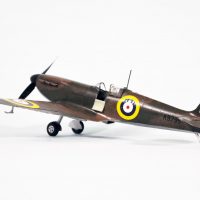
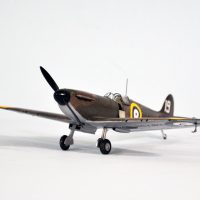
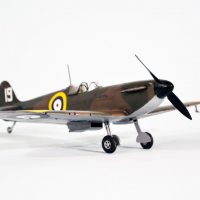
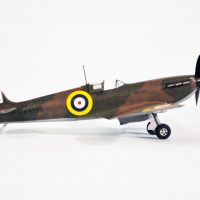
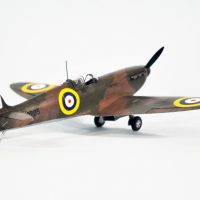
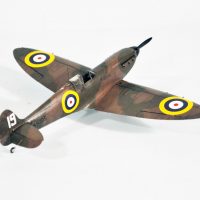
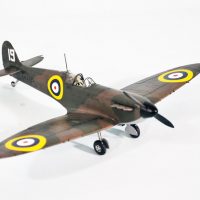
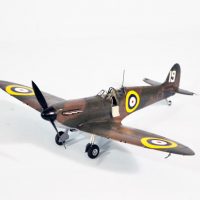
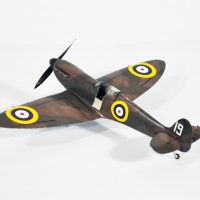
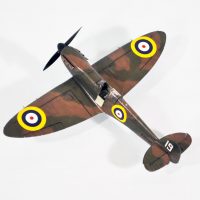
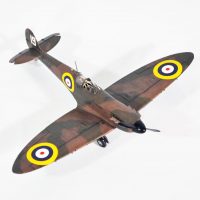
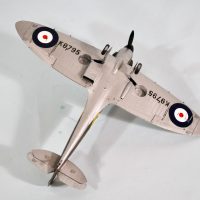
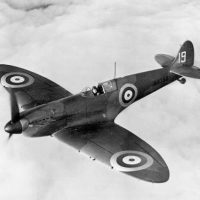
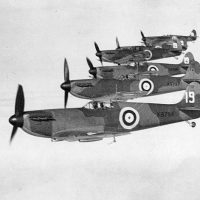

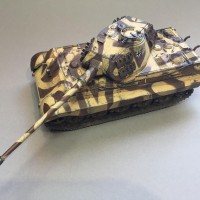
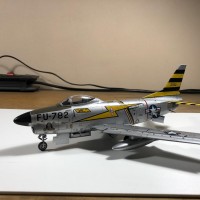
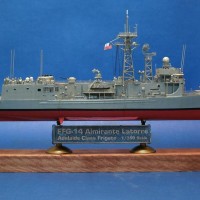
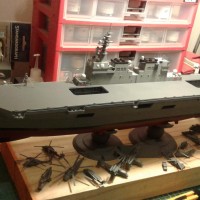
Good stuff Tom. Might have to put an end to my model buying embargo
Great looking Spit, Tom (@tcinla). I really like all of the new early Spits that are available.
Great build Tom. Thanks for the tip for glueing the wing guns.
Hi Tom @tcinla!
This is a wonderful job on the Early Spit, a subject I get to love more and more, together with the Eduard redndition(s).
It is interesting that Eduard today, at the age of subcontracting, strive to setup production lines and print their own decals, when some amazing, greatly setup and running (read Cartograf), decal businesses are not very far away from them, eager to undertake the job of producing magnificent decals for their magnificent models. How more expensive - if not in fact cheaper - would it be? A few modellers, myself included, love building OOB and this includes decals, so an excellent decal sheet to accompany this exquisite model would be my modelling heaven.
I loved your historical part: apart from nice new infos, you have a way to provide already known info in a freshly crisp way.
Thanks!
Good review as always, Tom.
A model can be correct and scale like and whatnot. However, when it comes to buildability and suited for the style of how one builds a model and what one wants to get out of it, it becomes a different matter. Price may also be a factor at times. Personally I do enjoy Tamiya in general for how things fit and how effortless a build can be. Just like Dragon brought tons of extra bits and details to a tank kit, it also only suited a very particular sort of builder. I still yet have to lay my hands on Tamiya's latest kits but I'm having a few of Eduard's Spitfire Mk IX series on the desk. For some reason I have not as much fun as I would like to have.
Another good argument for why there are so many different kits of the same subject from different sources. As the old saying goes, "One man's meat is another man's poison."
Nobody's going to argue that Eduard isn't "fiddly." They're practically the very definition of the word! They've managed to choose as subjects those airplanes that really fascinate me, and being your typical Aspergian nerd, I want as much accuracy as possible and will put up with "difficulty" in pursuit of such. So I will stand by the statement "this is the kit you want if you're a serious Spitfire Boffin."
Man that was fast, Tom! Looks really nice.
It went to the top of the pile of Zoom. 🙂
Another great build!
Really nice, Tom. Great review and history writeup. I've read elsewhere the there is an issue with Eduard only providing the manual gear retraction mechanism and not the follow on hydraulic one. If true, do you see this as a problem or is it pretty much invisible and just an issue for the "rivet counters"?
It's "problematic," but not a deal-killer to me. They should have provided that part. However, if it's really necessary and one has a kit that has that in it, it's easy to do a scratchbuilt copy that is "good enough" since it's not the most visible thing in the cockpit.
Great job. I really enjoy seeing your builds. I also enjoy reading your books.
I love hearing that last part! 🙂
"I Will Run Wild" is available for pre-order now at the Amazon "best seller" price and it gets released next month.
Well, it’s a good thing they stuck with “just the sort of silly name they’d give it” instead of SHREW, right? ?
That being said, I’m sure I do not qualify as a Spit boffin, but having built quite a few, it is my favorite aircraft. Considering exchange rates, taxes and shipping, this special boxing - what a dream to Spitfire fans - could easily reach the 1 grand mark local currency if ordered online. Reading about it is soothing, for now. Still, I have the latest Tamiya and Airfix in the stash - and the “stop-gap” Airfix from circa 2005? built as K9795. Thick wings and other problems, but proudly sitting on the display case with the wooden prop as the earliest Spit in my collection (a meager 9 1/48, 1 32 and 2 72). Perhaps one day I can lay my clumsy hands on one of these, but reading this sure helps!
Lovely build, as usual. Those early Spits are the best.
The Airfix and Tamiya are fine. If this didn't exist they'd be my favorites even with their little deficiencies. Here are (from L to R) the new Tamiya, the new Airfix, and the earlier Airfix.
3 attached images. Click to enlarge.
Another great build from your hands, Tom.
As always together with some nice to read history background and building detaisl.
Apparently, there are differences in the two fuselages in this boxing according to the host of Flory Models. Apparently, Eduard went so far as to rearrange the rivet pattern over the fuselage tank to represent the earlier Mk 1 vs the Mk II a . This was said in a off handed way on the program. However, in reading the Eduard site and their article they did note differences in the various models when it came to sheet metal thickness and armor plating for the earlier Marks. Which may account for the rivet pattern being different. Its apparent that Eduard did their home work.
My only niggle with Airfix's Spitfire is with the Dunlops the profile and cross section of the tires must have been copied from a contemporary tire off of a Warbird. That's being picky but, does show some of the research that the other manufacture put into their offerings and the range in prices for each kit. Easily remedy with a resin bit.
I think we'll see that difference in the next double combo release, the Spitfire IIa and IIb. Just checking the other fuselage in this release against the first one, these two are the same, with the only difference being the next one won't have the early gas tank (one of those things you have to worry about in the instructions, being certain to put the right bits on the right version).
But that's really interesting to know they went to that level of detail.
Well the devil is in the details and some folks are thinking about the long term survival or the longevity of their kits. I think of some of the Monogram classics as a prime example. To put so much R and D into kit is not the norm unless its a WingNut Wings kit. You have to be Fan Boy to appreciate...:)
There's a lot of "Spitfire fan boys," probably only mated by 109nutz.
Check out Brett Green's review with photos of the two "different" fuselages with photo's. The Mk I a kit has two vents underneath the wind screen and the sheet metal over the fuselage fuel tank does have a different rivet pattern with a subtle thickness for the thicker sheet metal. Also, the fuselage has a subtle feature for the armor found for the wind screen of the later mark. This is being picky, picky and over the top but, if your the "Fan Boy" who likes to show and tell your guests about the features of all things Spitfire...zowie.
Yeah, I discovered what is what when I just did the second one. Yes, there are (major) minor differences. Fortunately for me, by sheer chance, I chose the right fuselage for the first project!